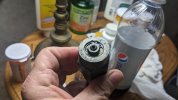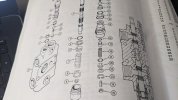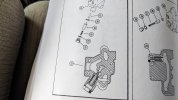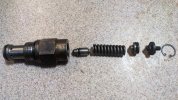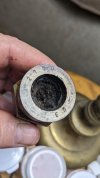Could you share with the members how you were able to to cross reference the Case part numbers to the ones on Grainger's website?
Thank you Clueless2 for your kind words. I have learned a bunch from people in this forum. It's great when people who know share what they know. Unfortunately this is my first real dealings with a real hydraulic system. I'm learning a bunch
As far as the cross-referencing, I will explain but if you have the same valve, it would be easiest to wait until I'm done and I'll post a list. The cross-referencing process is a very tedious, convoluted process that involves searching on the internet using the original Case part number in the parts manual. There are some web sites that will show the size of the O-ring along with the "dash" number, which equates to a specific standard size. I learned about dash numbers along the way because I've never dealt with O-rings before.
Once I found multiple sources to verify the dash size, which in some cases was nearly impossible, I searched the Grainger website for "O-rings". The results will show a row of O-rings at the top that are a sub-menu of what material you wish your O-rings to be. There are choices like Viton, which is great but really expensive. If you have not cost limitations, use this material, your seals will probably never need replacing in your lifetime. There are other materials. I used Buna-N which is a good, general all-round material that is resistant to petroleum products. Other choices are silicone, teflon (PTFE), neoprene, ect. I selected silicone for the in-between section seals because when installed, they are almost flat. I think Buna-N would probably rupture although the seals that come out looked like Buna-N, but I admit I don't know if other materials would look different. I would want these seals to remain pliable throughout their lifespan. The section O-rings I removed were hard as very hard plastic.
For those who have the same valve to rebuild, I will post all the cross-referenced part numbers for what I used. If you wish to use something other than Buna-N, the "dash" numbers will be the same but the Grainger part numbers will be different.
There are about 60 (61 exactly I think) O-rings required for the complete rebuild. Some of these O-rings are less than a dollar a piece but you have to order them in quantities of 50-100. The silicone rings are a bit more expensive. I am considering putting together complete rebuild kits and selling them for a fair (read fairly low) price. For that price I would label each O-ring as to where it goes, what dash number it is and the O-ring material. I would imagine that advertising and selling stuff here on the forums is discouraged or prohibited. If anybody would be interested in one of these kits, feel free to message me and we can discuss further.
If you would rather buy directly from Grainger, I can give a list. I'm going to wait until I have the valve all reassembled to make sure everything goes as planned before steering anyone down the wrong path.
